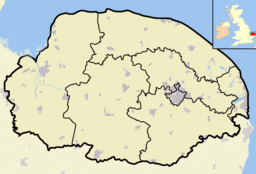- Muckleburgh Collection
-
The Muckleburgh Collection Military Museum Harrier on display at the museumFlagCountry England State United Kingdom Region East of England District Norfolk Location On the A149 coast road near Weybourne, Norfolk, United Kingdom Founded 1988 Visitation Full access. Accessible Toilets. (Opening Times April 2nd to October 29th 2006, 10am to 5pm,Monday, Tuesday, Wednesday, Thursday, Friday, Saturday and Sunday, Closed on Saturdays from October 7th.)
Muckleburgh Collection within NorfolkWebsite: Muckleburgh Collection The Muckleburgh Collection is a military museum sited on a former military camp at Weybourne, on the North Norfolk coast, England. It was opened to the public in 1988 and is the largest privately-owned military museum in the United Kingdom.
Contents
History
The museum is located on the site of the World War Two and post-war Weybourne Anti Aircraft Training Camp. Weybourne Camp is north west of the coastal village of Weybourne. The site was first used in 1935 by the Anti Aircraft Division of the Territorial Army as a temporary summer camp. In 1937 and as a result of the growing threat of war, it was decided to make the camp permanent and more fixed structures and defences were erected. During World War Two the camp was surrounded by a perimeter anti-tank ditch and defended by a system of gun emplacements and barbed wire. The interior of the camp consisted of groups of Nissen huts, barracks and other military buildings. The cliff top to the north was covered by a line of heavy anti-aircraft guns and batteries, slit trenches and pillboxes. As the war dragged on defences at Weybourne Camp became more complex and were altered regularly and significantly throughout the Second World War. In 1941 the camp was visited by Winston Churchill. During the war a grass airstrip was laid out which is still used. The camp was still used for gunnery until 1960. Much of the camp and its defences are now demolished.
The museum
When Weybourne Camp closed, the site was acquired by C. Berry Savory with his son Michael. At the time of the museum's opening in 1988, the principal display consisted of 30 vehicles and a small room describing the camp history.[1] The museum has expanded to include over 120 artillery pieces, tanks and other vehicles, many of which are in working order.
The Muckleburgh Collection is home to The Suffolk and Norfolk Yeomanry collection,[2] the Norfolk St John Ambulance archive, the North Norfolk Amateur Radio Group[3] and numerous special displays. The vehicles, museum site, and its unspoilt 300 acres (1.2 km2) has been used for television films, documentaries and dramas.[4]
The museum offers rides in a Gama Goat and hosts "tank driving" (the FV433 Abbot SPG). Among the 16 working tanks are Panzer P-68, Chieftain and Stuart M5A1, Soviet T-55 and Canadian-built Sherman tank.
Exhibits
- Ford GPA - amphibious Jeep
- Austin Tilly
- M3 Scout Car
- White M5 Half Track with M16 quad A/A gun
- Sexton self-propelled gun
- M24 Chaffee
- Chieftain tank
- Centurion tank
- Universal Carrier
- Patton tank
- T-55 Bridgelayer
- FV438 Swingfire
- T-34 85mm gun version
- Scorpion tank
- Tracked Rapier
- Churchill Crocodile - flame-thrower tank, but without trailer
- Austin K2 ambulance
- English Electric Thunderbird - A/A missile
- Diamond T tank transporter and Diamond T crane
- Leyland Hippo
- Alvis Saracen
- Ferret Armoured Car
- M29 Weasel
- M8 Greyhound
- Guns, missiles
- OTO-Melera 155mm gun
- Bristol Bloodhound - A/A missile
- QF 17 pounder gun
- Ordnance QF 2 pounder
- QF 6 pounder gun
- Morris C8 "Quad" and 25 pounder gun
- BL 5.5 inch Medium Gun
- 88 mm gun
- Aircraft
- Hawker Siddeley Harrier
- Armstrong Whitworth Meteor NF
- V1 flying bomb
Gallery
References
External links
Categories:- Military aviation museums in England
- Military history of Norfolk
- Military museums in England
- Museums in Norfolk
- North Norfolk
- Tank museums
Wikimedia Foundation. 2010.





